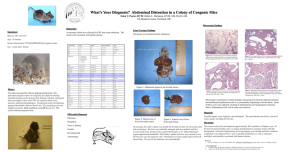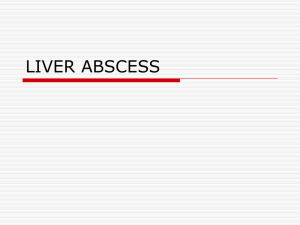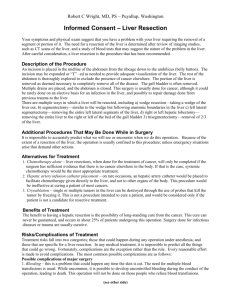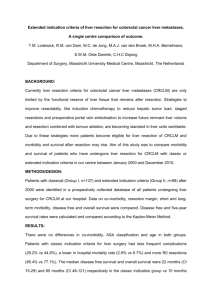Diseases of the Liver
advertisement
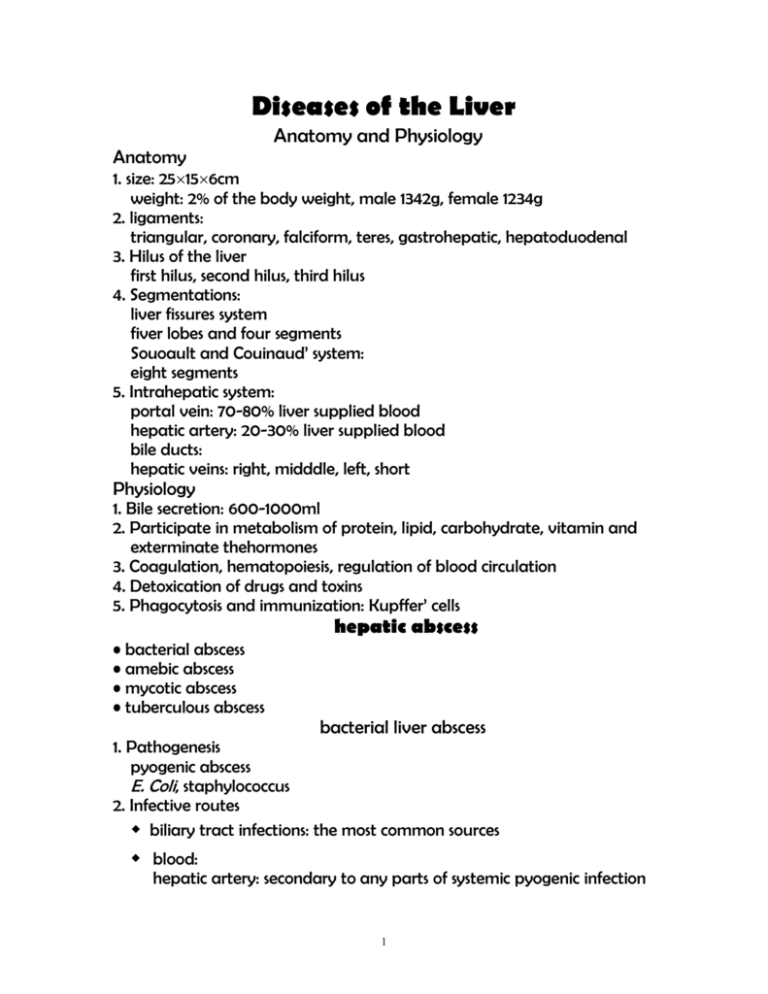
Diseases of the Liver Anatomy Anatomy and Physiology 1. size: 25156cm weight: 2% of the body weight, male 1342g, female 1234g 2. ligaments: triangular, coronary, falciform, teres, gastrohepatic, hepatoduodenal 3. Hilus of the liver first hilus, second hilus, third hilus 4. Segmentations: liver fissures system fiver lobes and four segments Souoault and Couinaud’ system: eight segments 5. Intrahepatic system: portal vein: 70-80% liver supplied blood hepatic artery: 20-30% liver supplied blood bile ducts: hepatic veins: right, midddle, left, short Physiology 1. Bile secretion: 600-1000ml 2. Participate in metabolism of protein, lipid, carbohydrate, vitamin and exterminate thehormones 3. Coagulation, hematopoiesis, regulation of blood circulation 4. Detoxication of drugs and toxins 5. Phagocytosis and immunization: Kupffer’ cells • bacterial abscess • amebic abscess • mycotic abscess • tuberculous abscess hepatic abscess bacterial liver abscess 1. Pathogenesis pyogenic abscess E. Coli, staphylococcus 2. Infective routes ◆ biliary tract infections: the most common sources ◆ blood: hepatic artery: secondary to any parts of systemic pyogenic infection 1 portal vein: intraperitoneal infection, intestinal infection ◆ lymph: subdiaphragmentic infection ◆ direct extension: blunt and penetrating injuries 3. Clinical presentation symptoms: ◆ general symptoms: chills and fever, anergy, loss of appetite, neusea, vomiting, jaundice ◆ local symptoms: abdominal pain in right upper quadrant, radiation of the pain signs: ◆ right upper quadrant tenderness ◆ hepatomegaly, ◆ hepatic percussion pain assistant examinations: ◆ blood routine examination: leukocytosis, anemia ◆ liver function tests: GPT↑, AKP↑ bilirubin ↑ ◆ positive blood cultures: 50% ◆ X-ray, BUS, CT ◆ percutaneous aspiration 4. Diagnosis and Differential diagnosis ◆ infective history ◆ symptoms and signs ◆ assistant examinations Differential diagnosis ◆ subphrenic and subhepatic abscess ◆ amebic abscess ◆ liver tumors ◆ biliary infection 5. Treatment ◆ supporting treatment: 2 ◆ antibiotics: ◆ percutaneous drainage: under BUS or CT: ◆ operation: surgical drainage intraperitoneal route amebic liver abscess 1. Etiology and pathology etiology amebic liver abscess is complication of intestinal amebic infections pathology amebas invade the colonic mucosa and be carried to the liver via portal vein. Within the liver these organisms multiply and produce a proteolytic enzyme, cause the liver cells necrosis and abscess formation complications: ◆ secondary bacterial infections ◆ discharge into subphrenic, pleural, lung, pericardial spaces, intraperitoneal and intestinal cavity 2. Clinical presentation and diagnosis ◆ lower fever, right upper quadrant abdominal pain; hepatomegaly with tenderness, hepatic percussion pain ◆ fecal examinations: amebic trophozoite ◆ colonoscopy: ulcers, amebas ◆ percutaneous needle aspiration: brown fluid ◆ respond to antiamebic therapy: 3. Treatment ◆ medicine treatments with antiamebic therapy ◆ percutaneous drainage under BUS or CT ◆ operation: indications: huge abscess with diameter>10cm complicated with bacterial infection rupture into adjoining structures no respond to antiamebic therapy no respond to percutaneous drainage 3 operative method: open drainage hydatid disease of liver 1. Pathogenesis and pathology Hydatid cyst is a hepatic cystic lesion that the liver is invaded by the larvae of ehinococcus granulosus. 2. Clinical presentations and diagnosis (1)asymptomatic in early and small or light pain in right upper quadrant, a mass can be occasionally found (2)compressive symptoms: gastrointestinal: neusea, vomiting biliary: objective jaundice portal vein: hepatomegaly ,splenomegaly, ascites (3)anaphylactic reaction: skin itching and rash, dyspnea (4)physical examination: mass in right upperquadrant, hydatid thrill, hepatomegaly (5)complications: infection: bacterial liver abscess rupture: biliary tract: colic and jaundice peritoneal cavity: anaphylactic shock (6)laboratory tests: peripheral esinophilia↑ Casoni’s skin test: 85% sensitive complement fixation test: (7)BUS, CT 2. Treatment operation: ◆ extirpation of inner capsule ◆ hepatolobectomy Liver Tumors primary liver cancer 1. Etiology and Pathology etiology: unclear, but relations with viral hepatitis, cirrhosis, aflatoxin and nitrosamine pathology: gross classification: nodular, massive, and diffuse types 4 microscopic classification: hepatocellular, cholangiocellular and mixed types metastases: intrahepatic blood and lymph direct invasion intraperitoneal seed-breeding 2. Clinical Presentations ■symptoms: ♥ local symptoms: abdominal pain ♠ gastrointestinal symptoms: anorexia, abdominal swelling, neusea, vomiting ♦ general symptoms: weight loss, fever, jaundice, ascites ♣ paracarcinoma manifestations: hypoglycemia, erythremia, hypercalcemia, hypercholesterinemia ■ signs: hepatomegaly with tenderness, mass ■ complications: hepatic coma gastrointestinal bleeding tumor rupture and infection 3. Diagnosis ■ history ■ symptoms and signs ■ assistant examinations: Laboratory Examinations: ● α-fetoprotein (AFP):≥400ng/ml★ ● serum enzymology: AKP, γ-GPT, LDH ● liver function tests ● hepatitis B or C antigen and antibody Imaging Diagnosis: ■ BUS ■ CT ■ MRI ■ hepatic angiography ■ nuclear scans ■ positron emission tomography (PET) 5 ■ needle biopsy ■ laparoscopy ■ laparotomy Differential diagnosis: secondary (metastatic) liver cancer hepatic abscess hepatic hemangioma 4. Treatment ● operative resection ● transarterial embolization (TAE) ● percutaneous ethanol injection (PEI) ● biological and gene therapy ● chemotheraphy ● radiotherapy ● Chinese medicine (1)operative resection Indications: ● localized lesions without exceeding half of the liver; ● no vascular invasion of main portal trunks and main hepatic vein Contraindications: ● serious jaundice, ascites; ● critical liver function damage; ● extrahepatic widespread tumor; ● not enduring for the operation with dysfunction of organs resection principles: regular resection: ● lobe resection if the tumor located in a segment ● half liver resection as the tumor limited in a lobe or invasion of near lobes ● three lobes resection when the tumor crosses a lobe or gets to half of the liver, but no obvious cirrhosis “radical local resection”: a resection to achieve 2cm margin of normal tissue unresectable tumors during operation: ● hepatic artery ligation ● catheterization ● alcohol injection 6 ● liquid nitrogen freeze ● microwave diathermy rupture and bleeding: ● conservative therapy ● hepatic artery ligation, plugging ● hepatolobectomy two-stage resection: recurrent re-resection: liver transplantation: (2)transarterial embolization (TAE) indications: ● unresectable big tumor; ● diffuse multiple tumors; ● recurrences and unsuitable for re-operation; ● postoperation contraindications: ● the tumor volume >70% of liver volume; ● serious jaundice, ascites; ● critical liver function damage; ● serious varices of esophagus and fundus of stomach; ● very poor general condition; ● dysfunction ofcoagulation; ● hypersensitive test to iodine (3)percutaneous ethanol injection (PEI) indications: ● tumor size < 3cm and in deep; ● tumor number <3 contraindications: ● tumor in the surface of liver (relatively); ● critical liver function damage, especially with ascites (4)biological and gene therapy: (5)chemotheraphy: (6)radiotherapy: (7)Chinese medicines: cavernous hemangioma of liver 1. Clinical presentations and diagnosis ● no symptoms in early stage and small size 7 ● abdominal pain in right upper quadrant ● gastrointestinal symptoms: anorexia, abdominal swelling, neusea, vomiting ● hepatomegaly and liver mass ● ultrasound, CT, M RI, angiography 2.Treatment ● observation and follow up: small and asymptomatic ● operation: >8cm Surgical resection hepatic artery ligation suture and ligation embolization freeze, microwave and sclerosis cyst of liver 1. Classification parapsitic cysts: hydatid disease of liver nonparapsitic cysts: congenital cysts: true cyst (single cyst and polycystic liver disease) traumatic cysts: inflammatory cysts: retention cysts neoplasm cysts: teratoma, cystic lymphangioma, cystadenoma 2. Clinical presentation and Diagnosis · small cysts: asymptomatic · large cysts: abdominal swelling and pain, compression of adjacent structures · hepatomegaly, mass · BUS, CT 3. Treatment · asymptomatic cysts require no treatment · large, asymptomatic, infected and with objective jaundice can be operated by either an open approach or laparoscopy fenestration (unroofed) operation drainage operation: internal and external cyst resection hepatolobectomy 8
